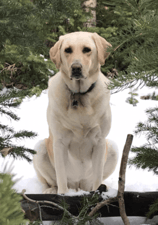 Counter surfing can be one of the most frustrating behaviors for dog owners to deal with — you might have spent hours on that perfect pot roast, only to have your pup sneak into the kitchen behind your back and pilfer it off the counter.
Counter surfing can be one of the most frustrating behaviors for dog owners to deal with — you might have spent hours on that perfect pot roast, only to have your pup sneak into the kitchen behind your back and pilfer it off the counter.
Not only is this annoying, but it can be dangerous for your dog if they steal food that is toxic or contains xylitol (which is highly toxic to dogs!).
Some dogs scarf the item down so quickly that they choke or it causes an obstruction in their gastrointestinal system.
Let's look at why dogs counter surf in the first place, and what you can do to stop it.
Why Dogs Counter Surf
 Counter surfing cost Lucy, the 5-year-old Lab, her life.
Counter surfing cost Lucy, the 5-year-old Lab, her life.Read the Wardrop family's heartbreaking story about how they lost Lucy after she counter surfed and ate keto-friendly bread made with xylitol.
Jumping up on the counter or kitchen table in search of food is a natural dog behavior. Dogs are scavengers and opportunists, and food (especially yummy-smelling human food) is hard to resist.
I would have a hard time just walking by a food truck giving away free tacos, and I’d definitely keep walking by that same spot every day to see if there’s another free taco giveaway going on.
Our human behavior changes based on what’s been rewarded, and it’s the same for our pups. The more a certain behavior is reinforced, the more your dog will choose to do it.
Most of the time, dogs are counter surfing when their human isn’t around, which makes this behavior difficult to correct in the moment. There’s no point in punishing your dog after the fact; if a consequence doesn’t happen right as your dog starts to misbehave, your dog isn’t going to make the connection we want them to make.
What usually happens if you punish your dog for counter surfing with yelling or using an aversive is that your dog learns to not even try and steal food when you’re around and waits for an opportune moment. But most importantly, there are better and more humane ways to address the counter surfing behavior!
Training your dog to not jump up on counters in search of food is all about:
-
Prevention
-
Teaching your dog incompatible behaviors
Preventing Counter Surfing
As the old saying goes: an ounce of prevention is worth a pound of cure! If your dog never learns that counter surfing results in getting a delicious snack, they are much less likely to make it a habit. Dog behavior is all about association; if jumping up on the kitchen counter has gotten them a piece of ham (even just one time!), your dog has learned that it’s a behavior worth trying again.
This first step of prevention is the same for dogs that have not yet learned to counter surf and for dogs that have already made it a habit. Take a look at your kitchen or whatever room your dog likes to jump on the counters, and think about ways you can manage the environment to prevent counter surfing from happening in the first place.
This includes:
- Blocking off access to the kitchen with doorway gates or freestanding gates
- Keeping your dog in their crate or in their ex-pen while cooking
- Keeping the kitchen counters clear of any food items
- Thoroughly cleaning counters after cooking to make sure there are no crumbs or food scents that would entice your dog to counter surf
By removing the temptation of counter surfing, you prevent it from being reinforced and set your dog up for success. Depending on your home setup, your dog’s house rules, and your expectations for your dog, sometimes this step is all you need to prevent and modify counter surfing behavior.
However, if it’s difficult to outfit your home with preventative measures like gates, or if your dog isn’t crate trained, it will be very important to teach them what to do when in the kitchen.
Training Incompatible Behaviors
When working on a problem dog behavior:
“Instead of (insert problem behavior here), I want my dog to (insert incompatible behavior here).”
It’s then up to you to teach your dog that it’s more rewarding to practice the alternative behavior than their previous bad behavior.
Some examples:
- Instead of jumping on the counter, I want my dog to go lay on their mat.
- Instead of counter surfing, I want my dog to sit.
- Instead of jumping on the kitchen table, I want my dog to leave it.
- Instead of climbing up on the counter, I want my dog to stay out of the kitchen entirely (boundary training).
Once you’ve chosen which incompatible behavior to teach your dog, start easy and stay consistent! Practice first with low distractions to set your dog up for success.
Don't expect them to be able to stay on their bed if you leave a juicy steak on the counter during their first session. Start small with no food item on the counter while you practice Go to Mat, and then slowly add in different food items to solidify (proof) your dog's Go to Mat behavior.
What Is Proofing a Dog's Behavior?
Teaching your dog not to counter surf depends on taking the time to "proof" the incompatible behavior you've chosen, which means you slowly raise criteria/difficulty level so your dog can be successful in the real-life context.
For counter surfing, in particular, an ambitious goal to aim for is having your dog leave something as high value as a juicy Thanksgiving turkey alone on the counter, even if no human is in the kitchen. And while that's the goal, you first start training them to ignore a boring vegetable that's on the counter.
As they are successful with different types of food, you continue increasing the distraction until eventually, your dog is ignoring that turkey because they know the incompatible behavior has been more rewarding.
This video by Kikopup provides an excellent overview of how to start easy and proof your dog to not counter surf:
Capturing Good Behavior
In the context of counter surfing, I prefer to teach incompatible behaviors without having to verbally ask the dog to perform them while I’m in the kitchen cooking or enjoying my meal at the dinner table. Instead, I train using what’s called capturing the desired behavior — marking and rewarding it when the dog chooses to do it on their own.
Clicker training is the easiest way to effectively use capturing when training your dog, but you don't have to use an actual clicker to do it. You can use a marker word, like "yes!", instead. Remember, the more a behavior is reinforced, the more a dog will choose to practice it!
Example: Capturing Sit
Here’s an example of capturing the Sit behavior with Mary Berry. This is her first session of practicing Sit in the kitchen while I prepare food on the counter. I’m not asking her to Sit, I’m waiting for her to offer it, clicking, and then treating. At the same time, she's learning that jumping on people doesn't get her anything.
Do you see how she starts to offer Sit faster and hold it longer as this short training session goes on?
Example: Teaching Your Dog to Stay Out of the Kitchen
Another incompatible behavior you can use to prevent counter surfing is the Invisible Boundary, or teaching your dog to stay out of the kitchen by choice.
Here's an example of Sookie learning to stay out of the kitchen area. This is her first training session using capturing to learn this new boundary. The blue tape isn't for her sake; it's there so I know when I can click for staying in the right space and when I need to help her reset her position. The treat is always tossed to her in the area she's allowed to roam.
As Sookie and I continue practicing this behavior, the next steps will include removing the blue tape that demarcates the boundary and waiting longer and longer between each click and treat to build the duration of her behavior.
I'll also practice with higher distractions happening in the kitchen; right now, I'm just playing with a bowl of already prepared food and standing at the counter, but I want to build her up to be able to stay outside of the kitchen area while I cook a meal and move around.
I'll be able to phase out the clicker and food treats by switching to what's called a variable schedule of reinforcement once I have the baseline behavior to build on. Check out this article to learn more about how to successfully fade out food treats in dog training.
Do you want to start teaching your pup an invisible border? You can use this behavior in a variety of situations, whether it's staying out of your kitchen to prevent counter surfing, teaching your dog to not bolt out the front door, or even used outside to teach your dog to stay in the yard and not run into the road.
Watch these great videos from Kikopup that show how to teach your dog an Invisible Border step-by-step:
If you have a dog that has learned to counter surf, or if you want to prevent your new pup from ever learning this bad habit, focus on managing the environment and teaching them what you want them to do instead.
If you're not sure how to properly set up your kitchen or are finding it difficult to train an incompatible behavior, connect with a certified professional dog trainer who uses force-free positive reinforcement methods to help you troubleshoot.
Get Personalized Virtual Help from a Certified Trainer for Your Dog's Jumping and Counter Surfing
Sign up for our Dog Training Essentials: Jumping & Counter Surfing Workshop to receive instant access to in-depth lessons, tips, and videos to stop your dog's counter surfing habit. All for just $9 — enroll today!




